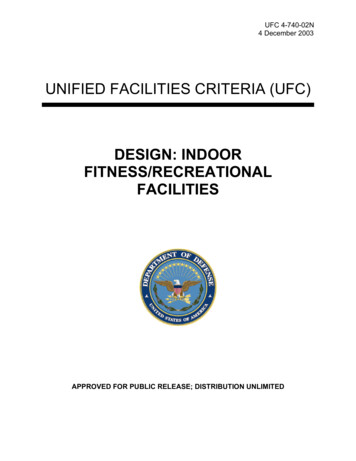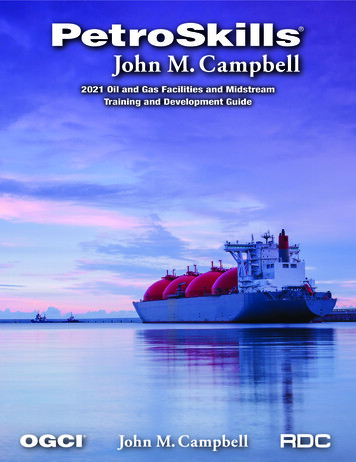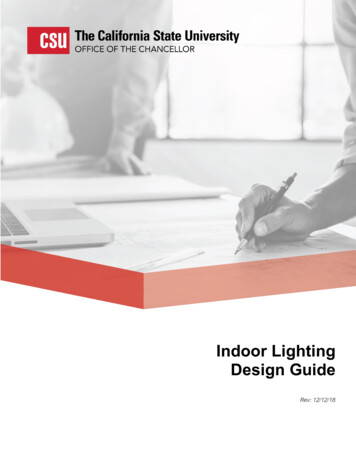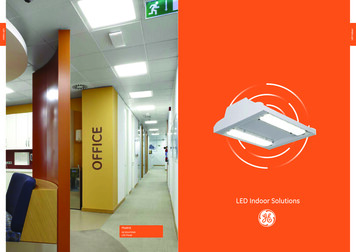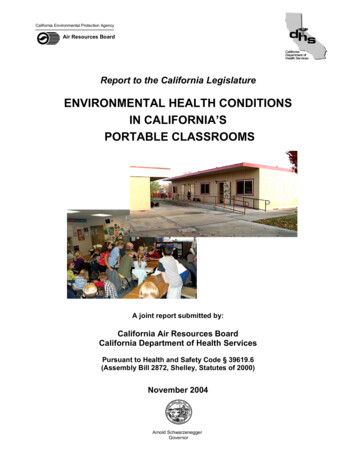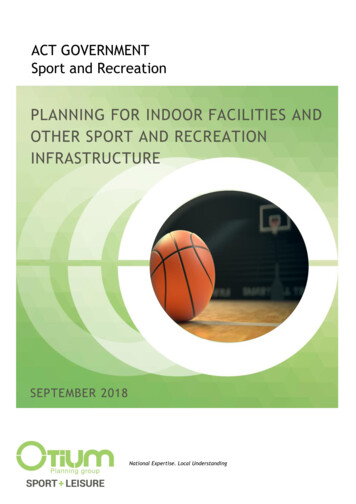
Transcription
ACT GOVERNMENTSport and RecreationPLANNING FOR INDOOR FACILITIES ANDOTHER SPORT AND RECREATIONINFRASTRUCTURESEPTEMBER 2018National Expertise. Local Understanding
OTIUM PLANNING GROUP PTY LTDHead Office:Level 660 Albert RoadSouth Melbourne VIC 3205Phone: (03) 9698 7300Sydney Office:Suite 1/ 273 Alfred St NorthNorth Sydney NSW 2060Phone: (02) 8011 0725Otium Planning Group (OPG) hasoffices in: Brisbane Cairns Darwin Melbourne New Zealand Perth SydneyThe OPG, IVG and PTA Partnershiphas offices in Hong Kong, Shenzhen,Shanghai and BeijingDocument HistoryDocument MACT S&RSJV631/8/2018DMACT S&RSJFinal25/9/2018DMACT S&RSJ 2018 Otium Planning Group Pty. Ltd. This document may only be used for thepurposes for which it was commissioned and in accordance with the terms ofengagement.
TABLE OF CONTENTS1.EXECUTIVE SUMMARY . 12.INTRODUCTION . 33.STUDY PURPOSE AND APPROACH . 54.SNAPSHOT OF KEY BACKGROUND RESEARCH . 64.14.25.POPULATION ANALYSIS . 6RECENT DOCUMENT REVIEW . 6STAKEHOLDER ENGAGEMENT FINDINGS . 75.1INDOOR SPORTS . 75.1.1Basketball . 75.1.2Futsal . 75.1.3Gymnastics . 85.2COMMUNITY COUNCILS . 86.COMMENT ON DEMANDS . 96.1SPORT DEMAND ANALYSIS . 96.1.1Basketball . 96.1.2Futsal . 96.1.3Gymnastics . 96.2LOCATION ANALYSIS . 97. PLANNING TO MEET FUTURE SPORT AND RECREATION NEEDS (THE CASE FOR A DIFFERENT LONGER TERMAPPROACH) . 107.17.28.LAND PLANNING . 10DEVELOPER CONTRIBUTIONS . 10OPTIONS ANALYSIS AND STRATEGIC DIRECTION . 128.18.28.38.4MODELS OF INDOOR FACILITY PROVISION . 12INDOOR SPORTS COURTS PERFORMANCE DATA . 13OPTIONS FOR INDOOR PROVISION IN ACT. 13STRATEGIC DIRECTION – INDOOR SPORTS/ AREAS WITHIN PROJECT SCOPE . 14APPENDIX A – BASKETBALL ACT MEMBERSHIP DISTRIBUTION . 16APPENDIX B – CONSOLIDATED KEY STAKEHOLDER FEEDBACK . 17
1.Executive SummaryBACKGROUNDThe 2015 ACT Indoor Sports Facility Study found that there is a shortage of multi-court indoor sport facilities in theACT and that demand for indoor courts will be exacerbated by population growth and the closure of the WodenBasketball Centre and Woden CIT. The study found that the most sustainable facilities have multiple courts that providefor a range of uses and incorporate ancillary services such as cafés, health & fitness and allied health. It noted thatsingle purpose (e.g. sport-owned) facilities require a strong business case to ensure that the organisation is able toviably operate them over time.STUDY AIMTo further progress the findings of the 2015 study, ACT Sport and Recreation sought a preferred facility strategy tomeet the needs of three high participation indoor sports - basketball, futsal and gymnastics - with a focus on threelocations, namely Gungahlin, Belconnen and Woden. ACT Sport and Recreation also sought commentary on differentapproaches to the planning and funding of sport and recreation infrastructure.STUDY APPROACHThe study process included an overview of current indoor facility provision in the three study areas; consultation withthe three indoor sports involved; meetings with representatives of Woden, Gungahlin and Belconnen CommunityCouncils; analysis of population data and recent planning reports; and an analysis of approaches to the planning andfunding of sport and recreation infrastructure in other jurisdictions.SNAPSHOT OF RESEARCH FINDINGSGungahlin has a high population (73,133 projected to grow to 117,506 by 2036); and a median age well below the ACTas a whole (lower median ages typically have a higher demand for sport and recreation infrastructure). Belconnen alsohas a high population (97,905 projected to grow by 18,098 by 2036) and a median age in line with the ACT as a whole.Woden has a comparatively moderate population (34,475), low projected growth ( 1,528 by 2036), and a significantlyhigher median age than the ACT as a whole.Recent plans/agreements (see section 4.2) have recommended provision of an indoor sporting facility in Woden orfeasibility studies for multi-purpose indoor facilities in Woden and Gungahlin.Indoor sporting facilities in Canberra have historically been provided in one of four ways (1) directly by the sportssector (2) by large licenced community clubs (3) through facilities at schools/ universities (4) by the private sector. Insome cases, ACT Government has provided capital funding support. Generally, sporting organisations have providedlarger centralised indoor sporting facilities (particularly for competitions purposes) rather than numerous smallerfacilities located across Canberra. As a result, many indoor sports have made strategic decisions over time where theynow have facilities located in key catchments that service multiple districts. This is particularly important whenconsidering the commercial viability and sustainability of indoor sporting facilities as high utilisation rates are animportant part of their ongoing viability.SNAPSHOT OF CONSULTATION OUTCOMESBasketball ACT has 8,809 active playing members. They are seeking a 3-court expansion of their 4-court facility atBelconnen Basketball Stadium to incorporate a High Performance Centre to host national competitions, conduct socialcompetitions, and accommodate team training. Capital Football has 21,673 registered players, of whom 4,792 (22%)are futsal players. They are seeking a dedicated football facility incorporating at least two indoor futsal courts.Gymnastics ACT has 5,200 participants, and are seeking a State Centre for high level training and the conduct of local,regional and higher level competitions. Canberra City Gymnastics Club is also seeking to relocate from its freeholdfacility which it has outgrown.From discussions with representatives from the Community Councils, Woden is seen as lacking activation and gatheringspace with a need for a multi-use facility incorporating indoor sport; Gungahlin indicated a lack of provision for sportand recreation land/ facilities generally and expressed the need for an easily accessible, multi-purpose indoor sportand recreation facility; Belconnen felt that basketball was adequately catered for in the area but the existinggymnastics facility was seen as unable to cater for demand.ACT Government – Planning for Indoor Facilities and Other Sport & Recreation InfrastructurePage 1
STRATEGIC DIRECTION FOR SPORTS/ AREAS WITHIN STUDY SCOPEThe ACT Government has not directly developed and managed indoor facilities. The provision, and wide distributionacross Canberra, of government-owned multi-purpose indoor sport & recreation facilities would have significant budgetimplications and may impact on the viability of existing sport-owned facilities. Accordingly, any future governmentprovision should be focussed only on those areas where there is high projected population growth, and the opportunityto offset capital costs via developer contributions (see below). In areas where no reasonable access to indoor facilitiesexists, partnerships with sports or schools should be considered.There is a need for indoor facility provision in Gungahlin, and to a lesser extent Woden, which is only likely to bepartially addressed by existing or proposed sport-provided facilities. Given budget limitations, developing shared useindoor facilities in schools would offer a more effective solution in these areas.In the longer term, this study recommends that the ACT Government adopt a more strategic approach to the planningand funding of sport and recreation infrastructure in new development areas which enables infrastructure to be funded(or co-funded) by developer contributions, as occurs in other states (refer section 7). This would ensure that sport andrecreation land/ facility needs are factored early into the planning process, reduce pressure on limited capital budgetsand deliver sport and recreation infrastructure in a more timely manner.Recognising historical facility provision arrangements and budget limitations within the ACT, the proposed strategicdirection and priorities for those sports and areas within the scope of the study are as follows:1. Pursue opportunities for partnership with an ACT Government school/college to deliver a multi-purpose indoorsport & recreation facility in Gungahlin.) Undertake a feasibility study to determine the facility mixcomponents, location, capital cost, funding arrangements, management arrangements, and operating viability.The design components should consider sports courts (min 2) and other potential complementary facilities (i.e.gymnastics training area, programming space, health & fitness, administration/ meeting areas, storage, food& beverage, and parking).2. Consider options to develop an indoor sport & recreation facility in Woden at an existing ACT Governmentschool/college. Undertake a feasibility study to determine the facility mix components, location, capital cost,funding arrangements, management arrangements, operating viability. This facility would be smaller than theGungahlin facility and design considerations should take into account any other existing private or governmentowned facilities within the catchment.3. Support the preparation, by Capital Football, of a detailed Business Case for the inclusion of indoor futsalcourts as part of a dedicated football facility in Gungahlin.4. Support the preparation, by Basketball ACT, of a detailed Business Case for their planned 3-court expansion ofBelconnen Basketball Stadium. If unsatisfactory, consider partnership opportunities with a school to deliver amulti-purpose indoor sport and recreation facility in West Belconnen, subject to a feasibility study which takesinto account any existing private or government owned facilities within the catchment and examines facilitymix components, location, capital cost, management arrangements, and operating viability.5. Support the preparation, by Gymnastics ACT, of a feasibility study to examine the location, facility mix, capitalcost, funding options, tenure and management arrangements, and operating projections for a dedicated StateGymnastics Centre, incorporating the relocation of Canberra City Gymnastics to underpin viability. Thefeasibility study should investigate the University of Canberra as the preferred site for the facility.6. To reduce pressure on limited capital budgets and deliver sport and recreation infrastructure in a moretimely manner, ACT Government should review its approach to the planning and funding of land and facilitiesto help cover the cost of delivering infrastructure needed to support new communities in population growthareas. This should include consideration of developer contributions as is common in other states (refersection 7).7. To ensure the future planning and provision of shared use sport and recreation facilities at ACT Governmentschools is appropriately considered early in the site identification, planning and design phase, a representativefrom ACT Sport and Recreation should sit on relevant planning committees within the Education Directorate.8. In the planning phase of any future shared use provision of indoor sports courts at schools, consideration shouldbe given to elements which may maximise community use and viability (eg health & fitness, food and beverage,programming areas, gymnastics training area).ACT Government – Planning for Indoor Facilities and Other Sport & Recreation InfrastructurePage 2
2.IntroductionIn 2015, ACT Government Sport & Recreation engaged Strategic Leisure Group 1 to prepare an Indoor Sports FacilityStudy. The study found, among other things that: Multi-court indoor facilities are important for the efficient running of competitions 2 Access to multi-court facilities in Canberra during peak times (4-10pm on week nights and during daytime onweekends) is highly competitive Most sports reported difficulty gaining sufficient court hours for competition and training which is inhibitingtheir ability to grow participation Some facilities are constrained by cost of hire and/ or not meeting contemporary design standards School facilities are underutilised, mainly due to lack of awareness, booking and access difficulties, or cost ofhire, but could meet demands for training space and free up court hours at larger venues There is a shortage of multi-court indoor sport facilities. Demand for indoor courts will be exacerbated bypopulation growth and a pending loss of four (4) courts at Woden Basketball Stadium and Woden CIT (bothsince closed).The report noted that the most effective and sustainable model of provision is usually a professionally managed, multicourt facility provided as part of a large multi-use venue (eg aquatic, indoor and fitness) that is able to accommodatea range of uses, and incorporates a range of ancillary services such as cafes and allied health. The development ofsingle purpose (eg sport-owned) facilities requires a strong business case to ensure that the organisation is able toviably operate them over time.The study set out the rationale for recommendations and strategies which included:1. Increasing community use of indoor sporting facilities at schools2. Ensure multi-court facilities are provided to service growth areas (focus on Molonglo and Gungahlin)3. Investigate sustainable options for increasing capacity and use of existing centres4. Ensure that all proposals for new or expanded facilities are tested for viability and sustainability5. Encourage sustainable provision of squash facilities at the current level6. Encourage ice sports to develop a future facility strategy7. Investigate options for improving gymnastics facilities within Canberra2.1Update on Implementation of Recommendations and StrategiesSince the release of the study, a number of recommendations and strategies have been implemented. While this workis ongoing, significant work has been undertaken to increase community usage of indoor sporting facilities at ACTGovernment schools (including schools in the regions identified in this report – Gungahlin, Woden and Belconnen).SCHOOLAlfred Deakin High SchoolWanniassa High SchoolLyneham High School12WORKS UNDERTAKEN Security system upgrade to allow for isolation of gymnasium from rest of the school Security system upgrade to allow for isolation of gymnasium from rest of the school Updated signage Upgraded lighting Improvements to fire doors linked to the gymnasium Security system upgrade to allow for isolation of gymnasium from rest of the schoolOtium Planning Group now comprises the directors and former staff of Strategic Leisure Group.Otium Planning Group research has found that, while suitable for training purposes, single court facilities are generally not functional forconducting competitions in court sports such as basketball, as only limited player numbers can be accommodated in an evening and the economiesof scale gained in multi-court facilities are absent.ACT Government – Planning for Indoor Facilities and Other Sport & Recreation InfrastructurePage 3
SCHOOLLake Tuggeranong CollegeHeadley Beare TrainingCentreAmaroo SchoolCampbell High SchoolWORKS UNDERTAKEN Security system upgrade to allow for isolation of gymnasium from rest of the school Upgraded lighting HVAC repairs Security system upgrade to allow for isolation of gymnasium from rest of the school Repairs, resealing and marking of parquetry floors Plumbing repairs to toilets, showers and hot water supply Removal and replacement of asbestos floor tiles in entry and storerooms Removal of trip hazards at entry points Extension of gymnasium to incorporate two basketball courts and associated amenities Upgrade of change roomsA number of sports have directly benefited from these improvements including two of those involved in this report(basketball and futsal).ACT Government – Planning for Indoor Facilities and Other Sport & Recreation InfrastructurePage 4
3.Study Purpose and ApproachTo further progress the 2015 Indoor Facility Study, ACT Government - Sport and Recreation engaged Otium PlanningGroup to recommend a preferred facility strategy to meet the needs of three high participation indoor sports basketball, futsal and gymnastics - with a focus on three locations, namely Gungahlin, Belconnen and Woden.Subsequent to the commencement of the study, Sport and Recreation sought commentary on models of public provisionof indoor sport and recreation facilities, and different approaches to the planning and funding of sport and recreationinfrastructure generally.This report responds to these objectives.The study process included: Examination of current indoor facility provision and usage in the three study areas Consultation with the three indoor sports involved in the study Meetings with representatives of Woden, Gungahlin and Belconnen Community Councils Meetings with Sport and Recreation officers Analysis of population data and recent planning reports and studies Examination of approaches to the planning and funding of sport and recreation infrastructure in otherjurisdictions.ACT Government – Planning for Indoor Facilities and Other Sport & Recreation InfrastructurePage 5
4.Snapshot of Key Background Research4.1Population AnalysisCurrent ACT Government population projections and analysis of median age as at the 2016 Census for the three studyareas are summarised at Table 1 below.Table 1: Population Projections and Median Age of Areas within the Scope of the 36,003GROWTH 2017-2036 18,098 44,373 1,528MEDIAN AGE34.931.940.7ACT MEDIAN AGE35Of the three study areas, it is evident that the Gungahlin region has a comparatively high population, the highestprojected growth to 2036, and a median age well below the ACT as a whole (lower median ages typically have a higherdemand for sport and recreation infrastructure). Belconnen has a high population, significant growth and a median agein line with the ACT as a whole. Woden has a comparatively moderate population, low projected growth, and asignificantly higher median age than the ACT as a whole.4.2Recent Document ReviewThe Draft Variation to the Territory Plan for Woden Town Centre includes a recommendation that “ the ACTGovernment amend the draft variation to reserve a large, flexible site in Woden suitable for future community,tertiary education or recreation uses such as an indoor sports hall or CIT facility.”3Section 12 (Public Infrastructure) of the Parliamentary Agreement for the 9 th Legislative Assembly for the AustralianCapital Territory between ACT Labor and the ACT Greens agrees to “Undertake feasibility studies into theconstruction of two multi-purpose indoor sports centres in Woden and Gungahlin.”3Standing Committee on Planning and Urban Renewal. “Draft Variation to the Territory Plan No 344 Woden Town Centre: Zone Changes andAmendments to the Phillip Precinct Map and Code. Recommendation 22.” December, 2017.ACT Government – Planning for Indoor Facilities and Other Sport & Recreation InfrastructurePage 6
5.5.1Stakeholder Engagement FindingsIndoor SportsFeedback from the three indoor sports within the study scope is summarised below.5.1.1BasketballBasketball ACT has 8,809 active playing members (2017 figures) representing a growth of 21% in the last three (3) years.The existing courts at Belconnen Basketball Stadium are at capacity during week days and weekends, and theAssociation utilises indoor courts at twelve (12) other school/ University or privately owned venues, primarily fortraining activities. Access to these external courts is constrained by their shared use with other sports or unavailability,often at short notice.The priority of Basketball ACT is a 3-court expansion of their 4-court facility at Belconnen Basketball Stadium toincorporate a High Performance Centre to host national competitions, conduct social competitions, and accommodatehigher levels of club training (currently undertaken at external venues). From information supplied by Basketball ACT,while the highest proportion of their members reside in the northern suburbs, the Belconnen facility services a wholeof city catchment and beyond (as does the Southern Cross Stadium in Tuggeranong) with high participation rates acrossall regions, including Queanbeyan (refer Appendix A). If developed, the expanded facility would free up existing schoolfacilities used by Basketball ACT for other, smaller indoor sports in the short to medium term (3-6 years).Basketball ACT has indicated a preparedness to contribute to the capital cost of the facility and would need to submita detailed Business Case to demonstrate its viability. Basketball ACT indicated that the proposed timeframe to considerany future expansion would likely be 4 years away once it has improved its current financial position. Basketball ACTacknowledges that any future upgrade at Belconnen will need to be delivered in partnership and likely require a directcash contribution from the ACT Government and additional finance to be secured.5.1.2FutsalFrom information supplied by Capital Football, there are 4,792 futsal players in their Association which represents 22%of their total 21,673 registered football players. Futsal participation has increased by 9% in the last 3 years but,according to the Association, growth has been hindered by limited access to indoor facilities.Capital Football accesses indoor courts at fifteen (15) school, university or privately owned venues throughout the ACT.They indicated there are a number of constraints regarding access to these facilities – for example, university facilitiesare under pressure to make their facilities available for university sports clubs and students; the AIS courts are sharedwith other indoor sports which have priority access and consistency of availability is impacted by AIS needs for theirNational Centre of Excellence programs and Australian representative camps; and demand for indoor facilities fromother sports such as martial arts codes and gymnastics/ cheerleading has also increased. The closure of mPowerdomeand less satisfying player experience at school halls has also impacted on participation.The priority of Capital Football is the development of a dedicated football facility in Gungahlin, with Capital Footballprepared to contribute to its capital cost. Capital Football is seeking to include at least two (2) indoor futsal courts aspart of the development which would have a synergy with small sided fields proposed to be situated adjacent to thefacility. The intent would be to maximise the use of the indoor courts for Capital Football’s competition and trainingpurposes. This could free up other indoor courts currently being used for futsal for other sports, however CapitalFootball believes there is a high level of latent demand for futsal which has not been met due to insufficient courtaccess, so this may not eventuate. Clubs in the north of Canberra have reportedly had to cap player numbers.Indoor courts could be designed to cater for future expansion should demand warrant. This could include thedevelopment of a satellite gymnastics venue, provided that it contributed to the overall financial viability of thefacility. Capital Football is currently working through a Business Case for a dedicated football facility and the numberof indoor (futsal) courts has not been finalised at this stage, although it anticipates that two (2) courts would be aviable proposition.ACT Government – Planning for Indoor Facilities and Other Sport & Recreation InfrastructurePage 7
5.1.3GymnasticsThe sport of gymnastics has experienced over 60% growth in the last five (5) years with approximately 5,200 participantsin the ACT. The sport has a high proportion of female participants (approx 75%) and young children aged 6-12 years(approx 50%).Each year 26-28 competitive events are held across different club venues which are not well equipped to cater forthem and clubs are unable to conduct other concurrent activities when these events are in progress.Gymnastics ACT is seeking a state centre for high level training and the conduct of local, regional and higher levelcompetitions. A dedicated venue for competitions is understood to be supported by affiliated clubs. The preferredoption of both Gymnastics ACT and Gymnastics Australia has been a facility based on, or adjacent to, the AIS. This nowappears to be unlikely given the recent decision by Gymnastics Australia to relocate their high performance programinterstate.Gymnastics ACT has indicated a preparedness to contribute financially toward the development of the facility (inpartnership with the ACT Government) which would be serviced by turnover from the operation of the centre. Thiswould require a detailed Business Case to be submitted by Gymnastics ACT to demonstrate its viability.An alternative could be the development of a new state centre at the University of Canberra (subject to the negotiationof mutually beneficial arrangements with the University). This facility could also accommodate the relocation ofCanberra City Gymnastics who have outgrown their freehold facility in Belconnen, the sale of which could potentiallyfund the development of their new venue. A new state centre would not be financially viable as a stand-alone event/high level training facility and the preferred model would see a gymnastics club co-located at the facility.5.2Community CouncilsA meeting with a Woden Community Council representative emphasised the loss of public and private indoor sport andrecreation facilities in Woden and a lack of activation and gathering space to service current needs and future highdensity development. It was suggested that this is contributing to youth issues and a perception of lack of safety. Theneed for a multi-use facility incorporating indoor sport was expressed. [It should be noted that a new commercial 20mLifestyle and Wellness Centre has recently opened in Phillip 4.]Similarly, the Gungahlin Community Council identified a lack of sporting and recreational opportunities for youngpeople and the need for an easily accessible, multi-purpose indoor sport and recreation facility. It was pointed outthat Gungahlin has an existing high population with high growth, and is constantly playing catch-up because provisionfor sport and recreation land/ facilities has not been planned for in the same way as schools.From discussion with a representative of Belconnen Community Council, basketball is considered to be well cateredfor in the area and no major demand for futsal has been evidenced. However, the existing gymnastics facility inBelconnen was seen as unable to cater for demand. It was felt that any new gymnastics facility should incorporate anexcellence program with a strong connection to the grass roots of the sport. As a general principle, the view wasexpressed that sport should partner with government in meeting future needs.4Australian Leisure Management, e-news, 8th March 2018. Described as the largest Anytime Fitness centre in Australia, the facility is an expansionof the Canberra Southern Cross Club on part of the old Southern Cross Pitch and Putt Club which was closed
The 2015 ACT Indoor Sports Facility Study found that there is a shortage of multi-court indoor sport facilities in the ACT and that demand for indoor courts will be exacerbated by population growth and the closure of the Woden Basketball Centre and Woden CIT. The study found that the most sustainable facilities have multiple courts that provide
